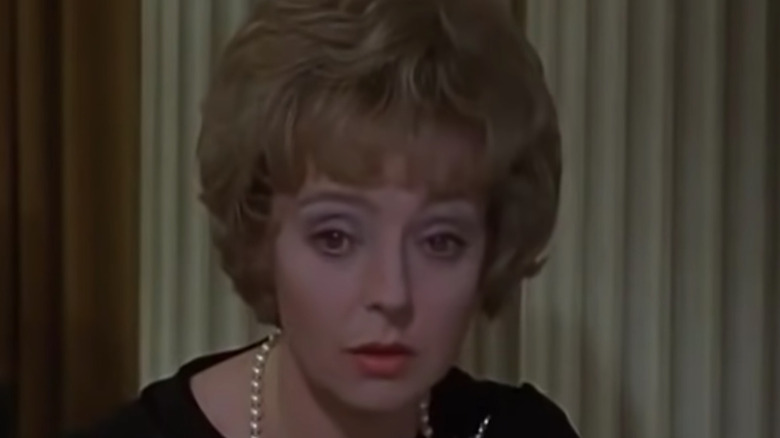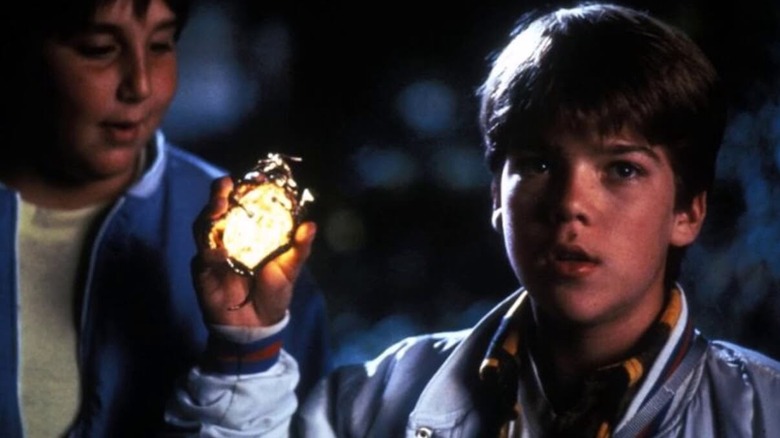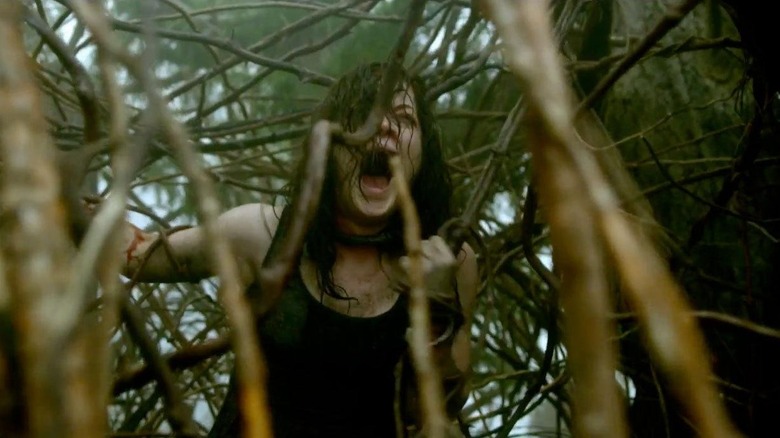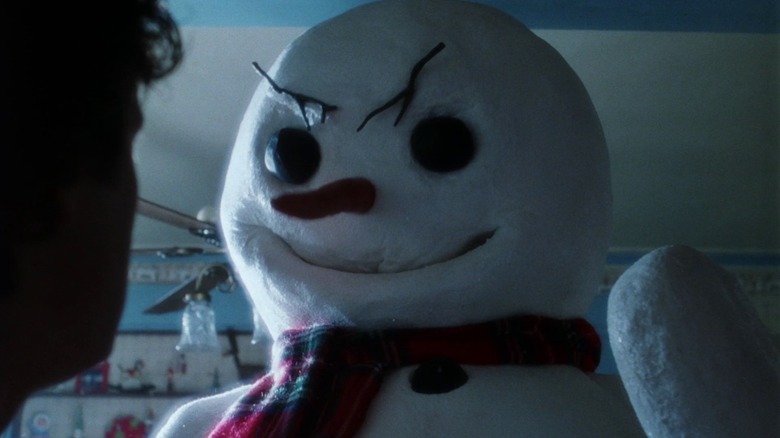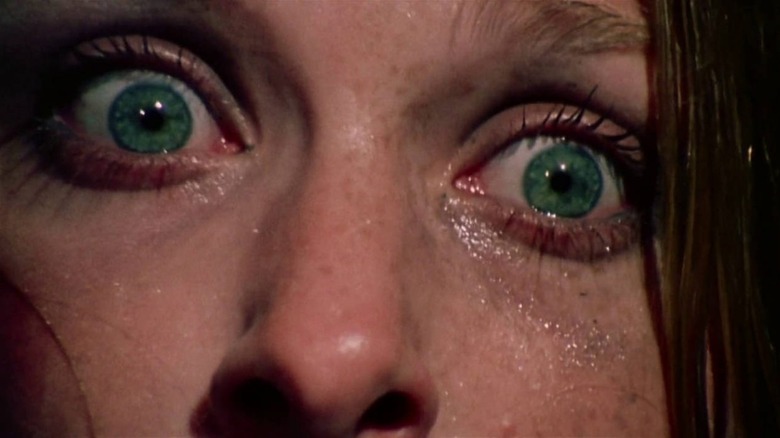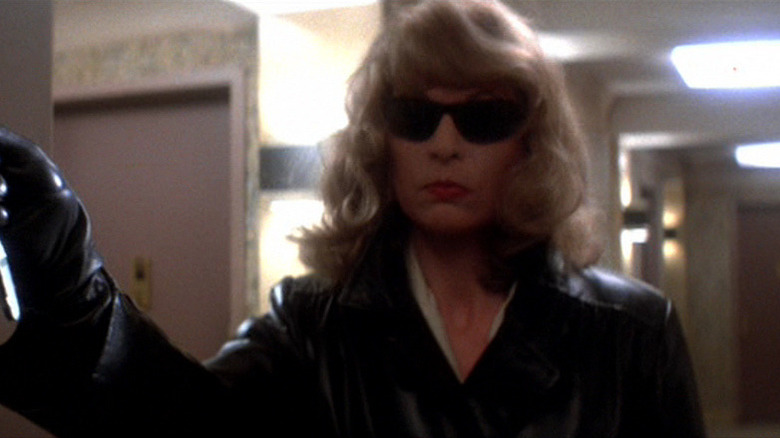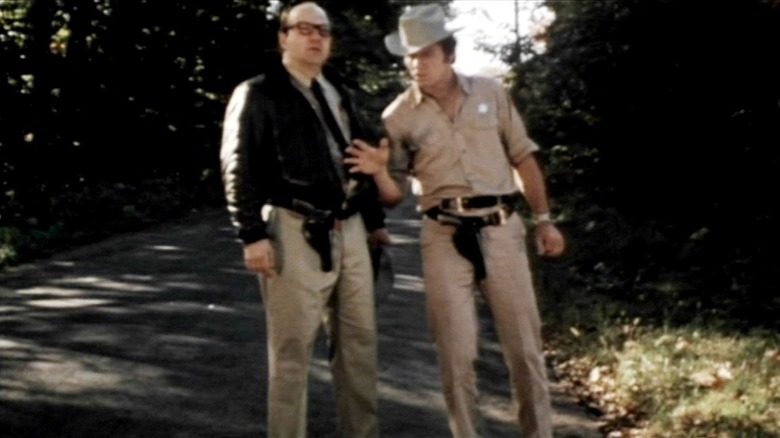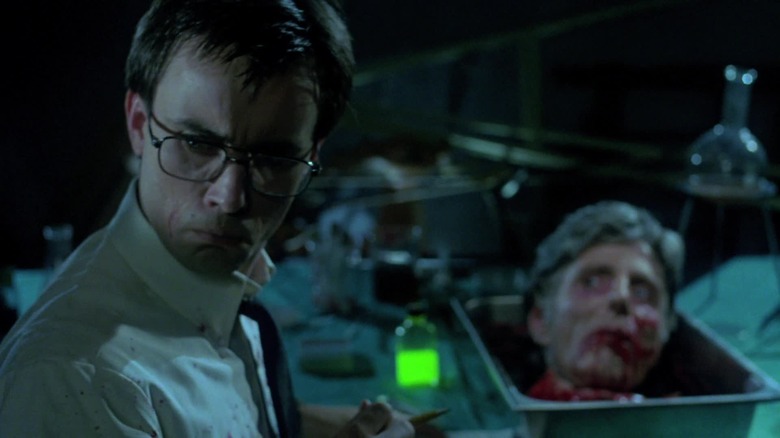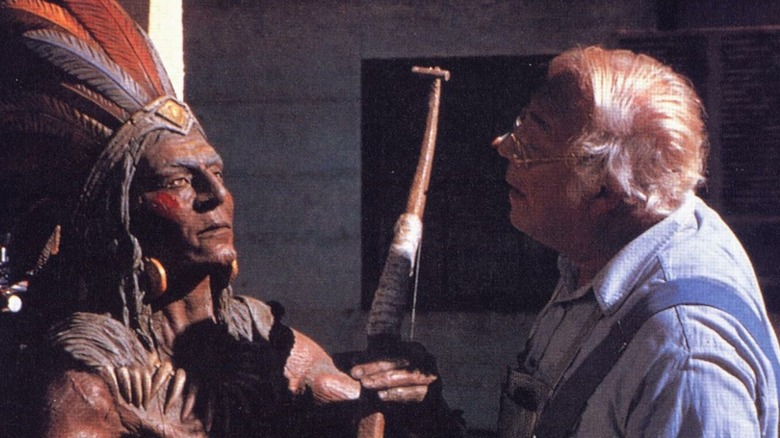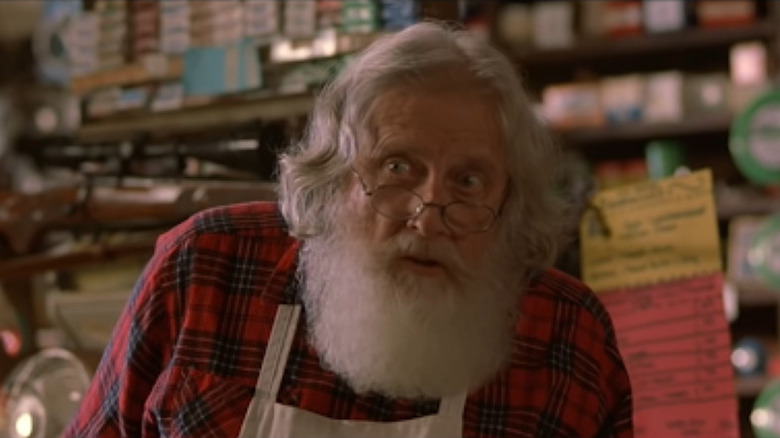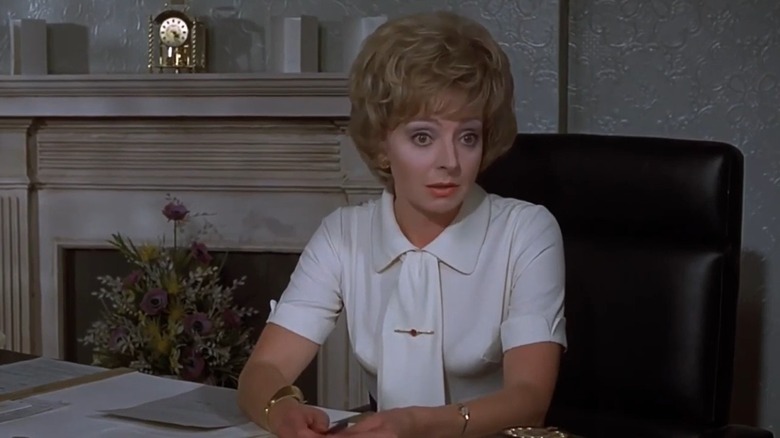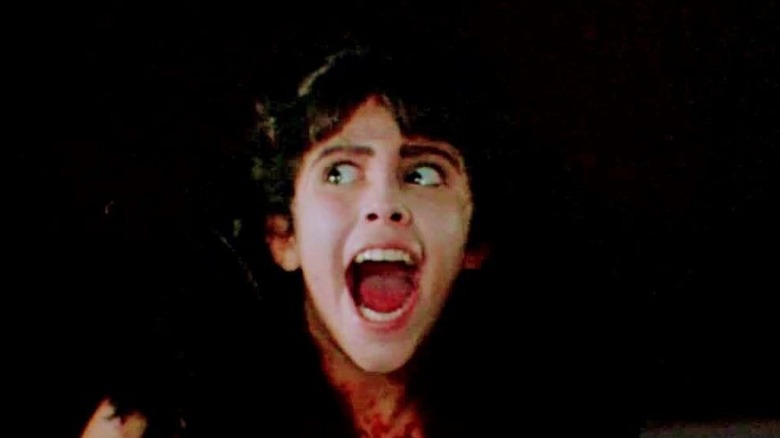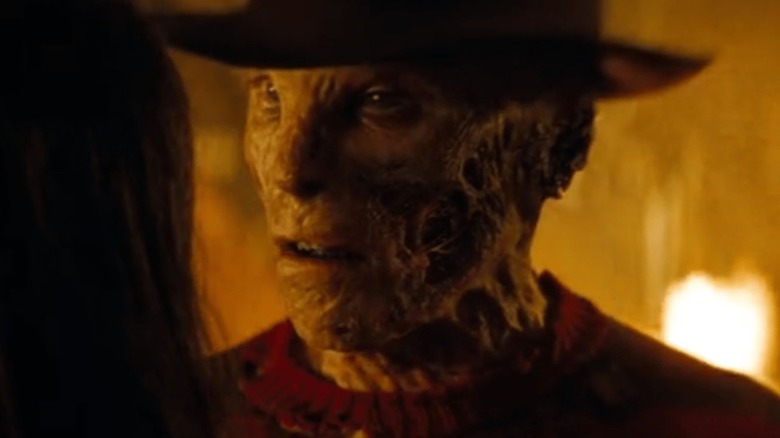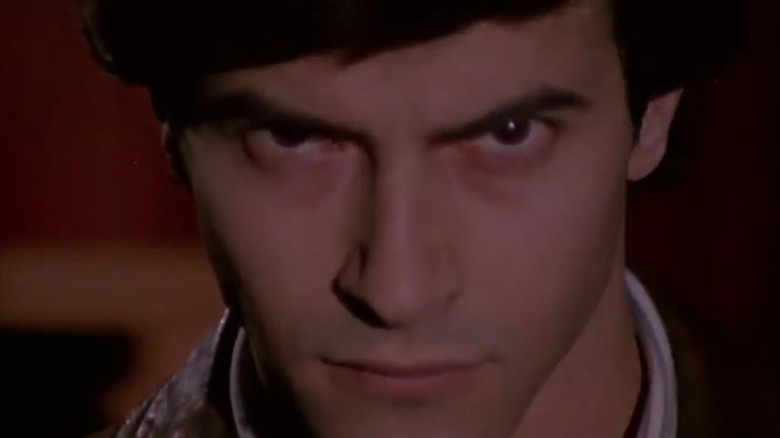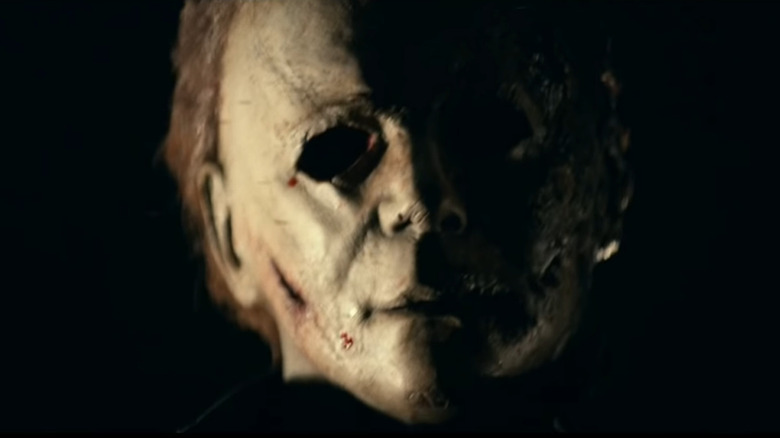The Most Cringeworthy Moments In Horror Films
When it comes to horror, cringing from the violence on the screen is to be expected. Whether it's a brutal slashing or a lumpen monstrosity lumbering at a victim, shrinking into your seat to escape the terror is a perfectly normal response.
That's not the type of cringe that we're talking about, though. The type of cringing we're interested in covers the moments that take you out of the film and make you question the filmmaker's choices. It's one thing to wonder why a scene plays out a certain way, and another to wonder why in the world anyone would commit that scene to film. The cringeworthy scenes can range from mild awkwardness all the way up to outright offensiveness, including gratuitous, outdated homophobia and misogyny. Anything that's hard to watch, basically. Some elements of horror are less horrific in a "sleep with the lights on" way and more in an "I need to cleanse myself forever of this image" way.
Because some of these moments could be triggering, we've added trigger warnings. Also, note that there are spoilers everywhere. Here, then, are the most cringeworthy moments in horror films.
Homophobia out of the mouths of babes in The Monster Squad
Trigger warning: Homophobic slurs.
Many viewers who saw "The Monster Squad" in 1987 have fond memories of it. Adorable moppets fighting monsters is a fun premise, even if the first line most think of when quoting from the film is Brent Chalem's Horace yelling, "Wolfman's got nards!" after kicking the Wolf Man in the crotch. Then the kids start slinging homophobic slurs.
Perhaps director Fred Dekker, who co-wrote the script with Shane Black, felt he was capturing verisimilitude. It makes sense that a film would reflect the way kids talk, especially in a horror-comedy where bad people are punished. Children in real life can be cruel in their ignorance. "The Monster Squad" features bullies such as E.J. (Jason Hervey), who calls Horace a "f****t" and other names, getting their comeuppance. Even for a PG-13 rating, though, these kids are foul-mouthed. And the film's heroes also use homophobic slurs, not to mention constantly referring to Horace as "Fat Kid" instead of by his name because Horace is overweight. One of the cringiest moments is when Monster Squad member Sean (Andre Gower) off-handedly remarks, "I mean, when they send you to school, why don't they tell you about the h*mos and the people with cat heads?" That kind of language is referred to as passive homophobia and it occurs in several 1980s movies. The rest of "The Monster Squad" can be enjoyable, but whenever a kid casually throws out a slur, it's cringe time.
Return of the infamous tree scene in the Evil Dead remake
Trigger warning: rape.
Women getting sexually assaulted is nothing new in film, particularly in horror. There's a whole subgenre of "rape revenge" films (think "Ms. 45" or "I Spit on Your Grave") wherein the woman gets even with her tormentors in graphic ways.
But when the assaulter is a tree? Sure, you could argue that it's transgressive, but it's also cringeworthy. The assault in 2013's "Evil Dead," which is somewhat less graphic than in the original 1981 "The Evil Dead," is actually more cringeworthy than its predecessor because of the cavalier way remake director Fede Alvarez discusses why the scene was included anyway: "I didn't write one scene and [the producer] asked 'where's my raping tree?' So *types on the table and whistles* raping scene, there you go." The producer was identified by B**ch Media as Robert Tapert, and Alvarez says in the film commentary that it was Tapert's idea for the remake as well as the original. The director of the original, Sam Raimi, expressed regret about the scene.
Even Ellen Sandweiss, who played Cheryl, the tree's victim in the original "The Evil Dead," says the tree scene would be different if filmed today. Although Ms. Magazine points out one crucial difference in the way Cheryl reacts versus the way Jane Levy's Mia reacts to the tree's violation in the original, we'd still put this as more cringeworthy because it was intentionally added back in after it had mercifully been left out.
Bathtub horror in Jack Frost
Trigger warning: rape.
In 1997's comedy-horror hybrid "Jack Frost," a serial killer literally named Jack Frost (Scott MacDonald) gets doused in chemicals and turns into a snow-covered monstrosity who wreaks bloody vengeance. It's an intentionally ridiculous villain origin story and the basis of some silly slasher mayhem. "Jack Frost" also has one of the most cringeworthy scenes in horror — the kind of cringe that makes you feel unclean for having seen it.
The scene occurs at the sheriff's house. Jill (Shannon Elizabeth) and her boyfriend, Tommy (Darren Campbell), break in and frolic. Jill, not realizing that Jack Frost is there and has killed Tommy, thinks Tommy drew a bath for her and gets in the tub. Rock music plays while she bathes. Then the music changes and a carrot pops up from the water near Jill's legs. The water turns to ice as Jack solidifies around her, violently raping her while bashing her head into the wall.
What makes the scene extra repugnant is that it's played for laughs. Peppy music accompanies the rape scene. Jack Frost looks at Jill's dead body and says, "Looks like Christmas came a little early this year!" He then puts his nose back in and quips, "Oh, I must remember to send flowers." The whole thing is vile. The scene also alludes to "Psycho" when Jill pulls the shower curtain down before her body is dropped to the floor. Alfred Hitchcock should rise from his grave and sue.
Scream and scream again in The Texas Chain Saw Massacre
"The Texas Chainsaw Massacre" (1974) is high in the pantheon of terrifying, low-budget horror films. Director Tobe Hooper made his bones bringing the tale of a misbegotten family of cannibals to bloody life as Sally (Marilyn Burns) and her brother Franklin (Paul A. Partain), along with some friends, travel to visit their family's old home. What they find instead is a house of horrors.
Leatherface's (Gunnar Hansen) murders are impressively gnarly, but it's the dinner scene near the end that brings on the cringe. Sally is tied up and tormented as the family of cannibals decides their Grandfather (John Dugan) should have the honor of killing her. The Hitchhiker (Edwin Neal), the Old Man (Jim Siedow), and Leatherface have to help the feeble man try to strike the killing blow with a hammer. Sally screams. And screams. And screams for what seems like hours, but is really less than six minutes.
Even without knowing that Burns was truly terrified while filming the dinner, the screaming seems interminable. It's been revealed that the dinner sequence took 26 hours to film, as mentioned in The New York Post article recounting the details from the behind-the-scenes book, "The Texas Chainsaw Massacre: The Film That Terrified a Rattled Nation." Burns' finger was actually sliced open for one portion of the grueling shoot, and she didn't even realize it at the time. That behind-the-scenes awfulness makes the moment insanely difficult to watch.
Transphobia and Misogyny in Dressed to Kill
Director Brian De Palma wears his Hitchcock influences on his sleeve. So when the big reveal in 1980's "Dressed to Kill" that the blonde slasher is really Michael Caine's Dr. Robert Elliott in a wig and dress, there's a good chance De Palma felt it might go over the same way that the Norman Bates/Mother reveal in 1960's "Psycho" did. Except Bates wasn't motivated by being a "crazy" trans woman.
Dr. Elliott is a psychiatrist whose patient, Kate (Angie Dickinson), is portrayed as "sex-starved." She tries to seduce him, but he rebuffs her. She then has a one-night stand with a stranger. When she's in the elevator after the assignation, she's attacked and slashed to death by a blonde. Dr. Elliott also has a trans patient, Bobbi, whom he has referred to another doctor because Bobbi is angry with him. Turns out Dr. Elliott and Bobbi are the same person.
The reasons behind Dr. Elliott's disguise are also cringe-inducing. Whereas Bates snaps after his mother's death and assumes part of her persona, Dr. Elliott is portrayed as both trans and having a split personality. Bobbi, his trans "side," is characterized as "unstable" because he won't let her have gender affirmation surgery, whereas Dr. Elliott, the male "side," is respected. It's a dual hit of so-called "female hysteria" and transphobia. Add the misogynistic characterization of Kate's sexual woes and you get some very dated cringe.
The two inept officers in The Last House on the Left
Comic relief is usually welcome in horror; every audience needs a bit of relaxation after the scary stuff. Then there's the type of comedy in the form of the two officers in 1972's "The Last House on the Left." Apart from being perpetually inept and taking forever to get to where they might be useful, the two also bring nothing to the table — not comedy, and certainly not relief from the unrelentingly grim proceedings in the rest of the movie.
The trope of Police Are Useless is not new. An early example is the Keystone Kops, who started appearing in 1912 in silent films. But there's something more cringeworthy in the antics of the Sheriff (Marshall Anker) and Deputy Harry (Martin Kove). Instead of providing respite from the torture inflicted by Krug (David A. Hess) and his gang on teenagers Mari Collingwood (Sandra Peabody) and Phyllis Stone (Lucy Grantham), they infuriate. While that may be director Wes Craven's point, it's still cringeworthy when they have to get a ride from a woman (Ada Washington) transporting chickens. It's played for laughs that two white cops need a ride from a Black woman with missing teeth in order to do their jobs because their incompetence has led their car to run out of gas, but even in the 1970s, that's bad optics.
Grotesque sexual assault in Re-Animator
Trigger warning: sexual assault.
In 1985's "Re-Animator," director Stuart Gordon's comedy-horror take on H.P. Lovecraft's novelette "Herbert West–Reanimator," medical student Herbert West (Jeffrey Combs) develops a way to reanimate the dead. The problem is his potion also results in a bit of ultra-violence on the part of the reanimated. West's illicit experiments are discovered by Dr. Hill (David Gale), whom West kills, decapitates, and reanimates. Hill's body eventually grabs his head and takes off to do nefarious deeds.
One of those deeds is kidnapping the dean's daughter, Megan, played by horror stalwart Barbara Crampton. Hill had been lusting after her, and having her under his control leads to the cringeworthy moment. An unconscious Megan is stripped naked and tied down on a medical table while Hill's head leers. The sexual assault starts while she's still unconscious, but she comes to in time to see what's happening. As Megan screams, cries, and begs him to stop, Hill's body grabs his head and positions it to lick her body, ending between her legs. It's a lot to process.
Fortunately, West arrives in time to stop the assault, taking Hill to task for wasting time fooling around with a "bubble-headed" co-ed. That part turns out to be a distraction so West's friend and Megan's boyfriend, Dan (Bruce Abbott), can rescue her, but the moment before was so cringeworthy that it briefly obscures West's intent, adding cringe on top of cringe.
Cringe at the racism and rape in Creepshow 2
Trigger warning: racism, sexual assault.
"Creepshow 2" is an anthology horror film with three different tales. In this case, two of the tales have cringeworthy moments.
In "Old Chief Wood'nhead," an old white couple have their death avenged by an object that comes to life. The object? A Native American cigar store statue. Ray (George Kennedy) and Martha Spruce (Dorothy Lamour) are a kindly old couple who own a general goods store in a small town. They are discussing retirement when Benjamin Whitemoon (Frank Salsedo) pays them in jewels for his tribe's debts. His ne'er-do-well nephew, Sam (Holt McCallany), rounds up a couple of friends to rob the Spruces, ultimately killing them. This does not please the statue, which comes to life and avenges them. It's a typical type of horror revenge story, but having a Native American warrior take revenge on another Native American in the name of a white couple is cringetastic.
In "The Raft," four friends are trapped on a wooden raft on a lake where an oil-like, black blob is alive and hungry. It dissolves its prey in a similar manner to what happens in 1958's "The Blob." Two of the four, Laverne (Jeremy Green) and Randy (Daniel Beer), survive into the next morning. While Laverne is still asleep, Randy decides to rape her. He's only stopped because the oily blob attacks Laverne. The act comes out of nowhere and is the very definition of cringeworthy and unnecessary.
Casual Racism in Cabin Fever
Trigger warning: racism.
Eli Roth's "Cabin Fever" is a vicious and mostly enjoyable bit of nihilism. A group of friends goes on a trip to a cabin in the woods where, one by one, they contract a voracious flesh-eating disease. It's pretty graphic and pretty gross–but that's not what's cringeworthy.
In horror movies where characters visit a rural area, they usually meet a sketchy local who acts weird and may or may not be villainous. In "Cabin Fever," it's the white convenience store owner, Old Man Cadwell (Robert Harris), the group meets when they stop to buy some supplies for their stay. He seems like your average, stereotypical yokel, with an added layer of racism when he drops an n-bomb out of nowhere. Paul (Rider Strong) and Karen (Jordan Ladd) ask him about the various items in his store and when Karen asks, "What's the rifle for?", he blithely says, "That's for [n-word]."
However, in the scene after the credits, it turns out the guy is not a racist–at least, not the way Roth leads us to believe. A group of Black friends comes into the store and things are a little tense until Roth flips the script–they are friends of Cadwell's, and they greet each other with the "softer" version of that word. It's a turn that's supposed to make us laugh because our expectations are upended. Instead, the tone-deafness of an old white man with an "n-word pass" just makes us cringe.
Punishing the divorced, successful woman in Frenzy
Trigger warning: rape.
In "Frenzy" (1972), the killer rapes and strangles women because of his deep-seated psychological issues. Robert Rusk (Barry Foster), the killer, has no problem with his friend, Richard Blaney (Jon Finch), taking the fall for his crime spree, either. In a film with that plot, seeing crimes committed is expected. However, Rusk's attack on Blaney's ex-wife, Brenda (Barbara Leigh-Hunt), is gratuitous.
The divorced Brenda is a successful matchmaker and Rusk has visited her agency before under an assumed name seeking companionship. Brenda found him creepy and his needs in a wife distasteful, so she didn't help him. He returns to see her anyway after she's spent time with Blaney to hit on her. When she refuses his advances, Rusk attacks her. Brenda tries several tactics to escape, but eventually Rusk rapes and strangles her.
The rape is not graphic; director Alfred Hitchcock held back on that, preferring to show Brenda's face as she distracts herself from the horror being visited upon her. However, the strangulation is very graphic, ending with the nearly topless Brenda's tongue lolling out of her mouth. None of the other murders, especially the ones of the nameless women victims of the "Necktie Killer," are shown in such detail. It's cringeworthy that the one murder that is depicted is of a successful, divorced woman who owns her own company.
The jaw-dropping ending of Sleepaway Camp
Trigger warning: Transphobia
Ever since it came out, 1983's "Sleepaway Camp" has sparked debate as to whether it is filled with transphobia, especially because of its shocking ending.
Angela (Felissa Rose) is orphaned after her father, John (Dan Tursi), and her brother, Peter (Frank Sorrentino), die in a boating accident. Angela is sent to live with her off-kilter Aunt Martha (Desiree Gould) and Martha's son, Angela's cousin Ricky (Jonathan Tiersten). Angela and Ricky go to summer camp, where a shy Angela is bullied and leered at, and a series of sub-"Friday the 13th" murders occur.
The cringeworthy part is the reveal at the end. It turns out that Angela was the one who died in the boating accident. Aunt Martha forced Peter to live as Angela because she already had a son and wanted a daughter. The years of abuse have taken their toll, and Angela takes out all her anger on the other campers. But it's not just that Angela was born in a male body–it's the body double they used for the reveal. Angela's frozen, growling countenance is superimposed on the body of someone who is clearly an adult male. After the frankly goofy movie before it, the ending is jarring and disturbing. Willow Maclay in cléo argues that the film is not just transphobic, but transmisogynistic, marking "the transgender female body as monstrous and murderous." It's enough to make anyone recoil.
Child murder is not enough in the A Nightmare on Elm Street remake
Trigger warning: child sexual abuse.
In the original 1984 "A Nightmare on Elm Street," the hideously scarred fiend, Freddy Krueger, was a child murderer who was burned alive by the parents of Elm Street. He returns in the dreams of the children of the Elm Streeters in order to kill them. He doesn't just look horrific–he is horrific. In the 2010 remake, though, the filmmakers apparently decided child murder wasn't horrific enough, so they went back to Wes Craven's original idea that Freddy was a child molester. It's an unnecessary level of monstrosity, making it cross over into cringe territory.
In this storyline, Freddy (Jackie Earle Haley) molests a group of children at daycare, and they tell their parents about the abuse. The parents burn Freddy alive, and he returns to murder the now-grown children in their sleep. It's not just the moment that Nancy (Rooney Mara) learns that she was molested and had forgotten that's cringeworthy–it's the whole idea that Freddy's victims get victimized by him twice, once when they're helpless and a second time because they turned him in. It's unlikely the filmmakers wanted the message to be that victims should stay quiet, but that's how it comes across and it's repugnant.
The entirety of The New York Ripper
It's hard to pick one moment as the most cringeworthy in Lucio Fulci's controversial "The New York Ripper" (1982) because the whole film is one long sequence of recoil-inducing moments. From the misogyny to the punishment of sex workers to the general sleaze factor, it's a cornucopia of cringe.
"The New York Ripper" is a giallo, a type of cinema known for its exploitative nature. Not all exploitation is equal, of course, and "The New York Ripper" frequently crosses over into unsavory territory even by the genre's standards. In the movie, a serial killer is on the loose, slashing and brutally murdering women who dare to have sex, or are prostitutes, or are sex-adjacent. Some men get killed, too, but men are not the focus of the killer's pathology.
The film is so over-the-top that it's been banned and censored multiple times–and it remains censored in the United Kingdom. It's been restored and re-censored in other countries so often, though, that even dedicated fans aren't sure which is the definitive uncut version. With "The New York Ripper" already a load of grotesqueries, including a close-up for the killer slicing a woman's eyeball with a razor blade, maybe it's just as well. Bonus cringeworthiness: The killer talks like Donald Duck (clip is audio only).
Myers Triumphant in Halloween Kills
In the latest installment of the "Halloween" franchise, "Halloween Kills" (2021), Michael Myers (James Jude Courtney) hacks and slashes his way toward his childhood home after surviving the burning trap set for him by Laurie Strode (Jamie Lee Curtis), her daughter Karen (Judy Greer), and her granddaughter Allyson (Andi Matichak).
Like Jason from the "Friday the 13th" series and Freddy Krueger down Elm Street way, Michael has become an anti-hero, someone the horror audience roots for even though he's committing terrible acts. Jason has inventive kills and Freddy has quips, while Michael has his "unstoppable force of evil" attribute. Sure, audiences cheer for the Final Girl's survival, but some also egg on the killer.
"Halloween" (2018) was a more measured depiction of Michael, returning to the roots of what made his implacable evil so terrifying. "Halloween Kills," however, has a lot more in common with 1981's "Halloween II"–lots of random murders while our ostensible heroine, Laurie, is sidelined in the hospital. "Halloween Kills" also has a cringeworthy scene late in the film. Haddonfield's townsfolk, led by Tommy (Anthony Michael Hall)–who was one of the children Laurie was babysitting that fateful night in 1978–fight back, beating Michael nearly to death, only for him to rise triumphantly and slaughter them all in grotesque ways. It's that slow rise as he gets off the ground and then the absolute devastation he causes that makes it seem like we're supposed to be rooting for him. It's cringe-inducing–and disappointing, too.
